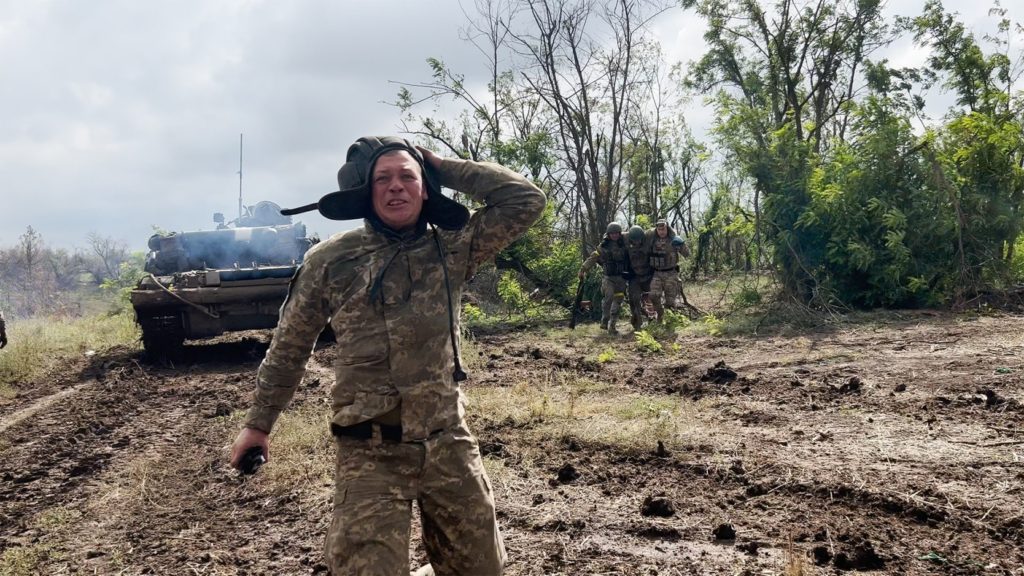Eastern Front (2023) by Vitaly Manski & Yevhen Titarenko

When the Russian invasion of Ukraine started, the young filmmaker Yevhen Titarenko had no doubt what to do: he volunteered for the paramedic unit and also took his camera with him. Regarding the paramedic work, it was not his first time on the frontline: he was also in Donbas at the early stage of war in 2014/15. This way, he obtained some raw, first-hand footage of him and his friends in action in different stages of war, from the beginnings on the Kiev front on.
That is only one part of the documentary Eastern Front that premiered at Berlinale’s Encounters section. And for the other one, Titarenko teamed up with the famed Ukrainian documentarist Vitaly Mansky who followed his young colleague and his war comrades during their rest period spent in the Carpathian region of West Ukraine. There, the men tried to make some sense of what is happening to them and their country both intellectually and emotionally in long conversations on the topics of politics and recent history (including the family histories of awakening from the toxic influences of Russian propaganda).
For the rawness and directness of the footage, Eastern Front is certainly not an easy watch, although it is a captivating one. Titarenko’s footage starts from the fairly recognizable point: the bombed out bridge in Irpin and the transportation of the wounded people over an improvised one, only to take us further into the ambulance car during the heart-stopping sequence of race against the time to save the life of a seriously wounded soldier and later to take us deep into hell of the war zone in the east of Ukraine where the team of paramedics in a car has to do the triage and take only the most gravely injured ones.

The other sequences, following the men on their “recess” from the time on the front line, are informative on another level, offering the insight into the history of the conflict and the repression and colonization that preceded it. Mansky is certainly not a stranger to those topics, as we could see in his previous documentaries, most notably in Close Relations (2016), where he studied the reactions of the members of his own extended family to propaganda coming from different sources. Here, however, the famed filmmaker had to adapt his approach from the essayistic with a lot of narration and perfectly arranged visuals shot in long, often static takes to be used as pieces of commentary, and to focus on something else: the conversations and the interactions of Titarenko and his buddies. It does not mean that Mansky does not tries and manages to sneak an introduction told in his usual tone and some pieces of commentary in the film, because he does, to a certain effect.
The problem is that, in the scope of ambitions to tell the whole story, Eastern Front hardly functions as a singular film, as it feels like two or more different films made by different people and different crews welded together in a way that is not clumsy per se, but is not particularly deft either. Simply, the differences of styles, approaches and production values are pretty extreme and sometimes contradictory: while the footage from the frontline, both urban and rural aims for urgency, but is defined by its rawness, the calmer, more pensive and artistically accomplished parts try to offer some explanation to the situation that we have heard before in the Ukrainian documentaries from before the war went full-scale.
Original title: Shidny front
Year: 2023
Runtime: 98’
Countries: Ukraine, Latvia, Czech Republic, USA
Languages: Ukrainian, Russian
Directed by: Yevhen Titarenko, Vitaly Mansky
Written by: Vitaly Mansky
Cinematography: Yevhen Titarenko, Ivan Fomichenko
Editing: Andrey Paperny
Sound: Václav Flegl
Produced by: Natalia Manskaia, Natalia Kazhan
Production companies: Studio Vertov, Braha Production Company, Hypermarket Film, Current Time TV
Sales: Deckert Distribution
















